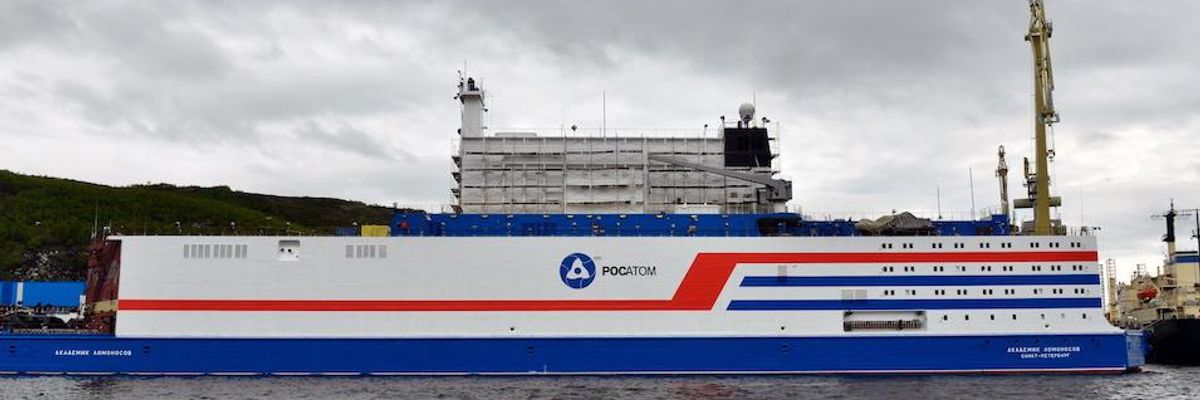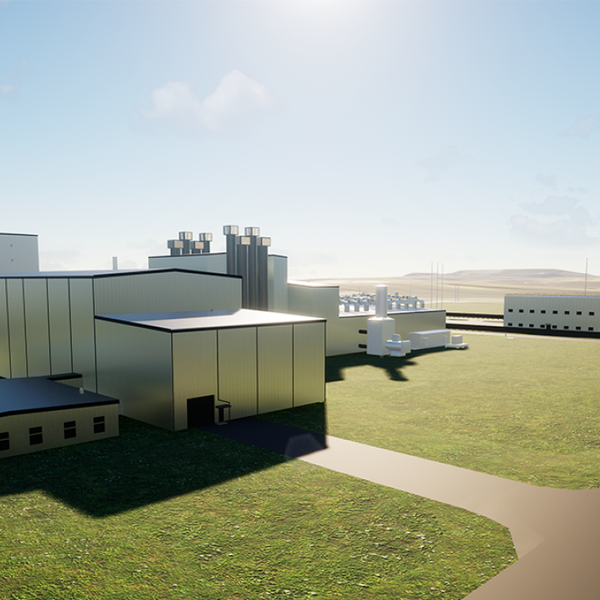
A view of Akademik Lomonosov, a floating nuclear power unit, its hull painted at the Atomflot base; being part of a floating nuclear power station, the vessel belongs to a new class of energy sources based on Russian nuclear shipbuilding technologies. (Photo: Lev Fedoseyev\TASS via Getty Images)
'Chernobyl on Ice': Nuclear Plant Barge Headed Across Arctic Circle
Shipment of nuclear plant across polar waters draws criticism
Its official name is the "Akademik Lomonosov," but critics call it a "floating Chernobyl."
Whichever title you prefer, the floating barge nuclear plant is heading across the Arctic Circle. A project of the Russian government, the plant is headed to the far eastern town of Pevek on Russia's Arctic north coast to provide power to energy projects in the North Pole.
According to CNN:
The Admiral Lomonosov will be the northernmost operating nuclear plant in the world, and it's key to plans to develop the region economically. About 2 million Russians reside near the Arctic coast in villages and towns similar to Pevek, settlements that are often reachable only by plane or ship, if the weather permits. But they generate as much as 20 percent of country's GDP and are key for Russian plans to tap into the hidden Arctic riches of oil and gas as Siberian reserves diminish.
The Lomonosov has been the target of criticism from Greenpeace for years. The environmental group first coined the name "Chernobyl on ice."
But the company behind Lomonosov, Rosatom, takes exception at comparing its barge plant to the famed site of the world's worse domestic nuclear disaster.
"It's totally not justified to compare these two projects," the Lomonosov's chief engineer for environmental protection, Vladimir Iriminku, told CNN. "These are baseless claims, just the way the reactors themselves operate work is different."
The barge's operators have learned from the disaster at Fukushima, Japan as well, they said.
"This rig can't be torn out of moorings, even with a 9-point tsunami, and we've even considered that if it does go inland, there is a backup system that can keep the reactor cooling for 24 hours without an electricity supply," said Lomonosov deputy director Dmitry Alekseenko.
Bellona, a nonprofit that observes nuclear projects and their environmental impacts, found in April that 24 hours could be insufficient time to avoid disaster if the rig was torn out of its moorings and landed somewhere where escape is difficult due to the polar environment.
In an interview with The Verge, Dale Klein, the former head of the Nuclear Regulatory Commission under President George W. Bush, called the plant's nickname a "scare tactic." However, Klein acknowledged that the potential for disaster from the Lomonosov could be catastrophic if something were to go wrong.
"If there were a problem out in the middle of the ocean, you would probably never see it on land," said Klein. "Or, you might be able to measure it, but it would be such a minimal impact [on land] because the ocean is so big. But if you have this barge that's anchored providing electricity 24 hours, seven days a week, and you had a spill, then it could get into the environment locally onshore."
"And so," said Klein, "you'd have to make sure that that never happens."
An Urgent Message From Our Co-Founder
Dear Common Dreams reader, The U.S. is on a fast track to authoritarianism like nothing I've ever seen. Meanwhile, corporate news outlets are utterly capitulating to Trump, twisting their coverage to avoid drawing his ire while lining up to stuff cash in his pockets. That's why I believe that Common Dreams is doing the best and most consequential reporting that we've ever done. Our small but mighty team is a progressive reporting powerhouse, covering the news every day that the corporate media never will. Our mission has always been simple: To inform. To inspire. And to ignite change for the common good. Now here's the key piece that I want all our readers to understand: None of this would be possible without your financial support. That's not just some fundraising cliche. It's the absolute and literal truth. We don't accept corporate advertising and never will. We don't have a paywall because we don't think people should be blocked from critical news based on their ability to pay. Everything we do is funded by the donations of readers like you. Will you donate now to help power the nonprofit, independent reporting of Common Dreams? Thank you for being a vital member of our community. Together, we can keep independent journalism alive when it’s needed most. - Craig Brown, Co-founder |
Its official name is the "Akademik Lomonosov," but critics call it a "floating Chernobyl."
Whichever title you prefer, the floating barge nuclear plant is heading across the Arctic Circle. A project of the Russian government, the plant is headed to the far eastern town of Pevek on Russia's Arctic north coast to provide power to energy projects in the North Pole.
According to CNN:
The Admiral Lomonosov will be the northernmost operating nuclear plant in the world, and it's key to plans to develop the region economically. About 2 million Russians reside near the Arctic coast in villages and towns similar to Pevek, settlements that are often reachable only by plane or ship, if the weather permits. But they generate as much as 20 percent of country's GDP and are key for Russian plans to tap into the hidden Arctic riches of oil and gas as Siberian reserves diminish.
The Lomonosov has been the target of criticism from Greenpeace for years. The environmental group first coined the name "Chernobyl on ice."
But the company behind Lomonosov, Rosatom, takes exception at comparing its barge plant to the famed site of the world's worse domestic nuclear disaster.
"It's totally not justified to compare these two projects," the Lomonosov's chief engineer for environmental protection, Vladimir Iriminku, told CNN. "These are baseless claims, just the way the reactors themselves operate work is different."
The barge's operators have learned from the disaster at Fukushima, Japan as well, they said.
"This rig can't be torn out of moorings, even with a 9-point tsunami, and we've even considered that if it does go inland, there is a backup system that can keep the reactor cooling for 24 hours without an electricity supply," said Lomonosov deputy director Dmitry Alekseenko.
Bellona, a nonprofit that observes nuclear projects and their environmental impacts, found in April that 24 hours could be insufficient time to avoid disaster if the rig was torn out of its moorings and landed somewhere where escape is difficult due to the polar environment.
In an interview with The Verge, Dale Klein, the former head of the Nuclear Regulatory Commission under President George W. Bush, called the plant's nickname a "scare tactic." However, Klein acknowledged that the potential for disaster from the Lomonosov could be catastrophic if something were to go wrong.
"If there were a problem out in the middle of the ocean, you would probably never see it on land," said Klein. "Or, you might be able to measure it, but it would be such a minimal impact [on land] because the ocean is so big. But if you have this barge that's anchored providing electricity 24 hours, seven days a week, and you had a spill, then it could get into the environment locally onshore."
"And so," said Klein, "you'd have to make sure that that never happens."
Its official name is the "Akademik Lomonosov," but critics call it a "floating Chernobyl."
Whichever title you prefer, the floating barge nuclear plant is heading across the Arctic Circle. A project of the Russian government, the plant is headed to the far eastern town of Pevek on Russia's Arctic north coast to provide power to energy projects in the North Pole.
According to CNN:
The Admiral Lomonosov will be the northernmost operating nuclear plant in the world, and it's key to plans to develop the region economically. About 2 million Russians reside near the Arctic coast in villages and towns similar to Pevek, settlements that are often reachable only by plane or ship, if the weather permits. But they generate as much as 20 percent of country's GDP and are key for Russian plans to tap into the hidden Arctic riches of oil and gas as Siberian reserves diminish.
The Lomonosov has been the target of criticism from Greenpeace for years. The environmental group first coined the name "Chernobyl on ice."
But the company behind Lomonosov, Rosatom, takes exception at comparing its barge plant to the famed site of the world's worse domestic nuclear disaster.
"It's totally not justified to compare these two projects," the Lomonosov's chief engineer for environmental protection, Vladimir Iriminku, told CNN. "These are baseless claims, just the way the reactors themselves operate work is different."
The barge's operators have learned from the disaster at Fukushima, Japan as well, they said.
"This rig can't be torn out of moorings, even with a 9-point tsunami, and we've even considered that if it does go inland, there is a backup system that can keep the reactor cooling for 24 hours without an electricity supply," said Lomonosov deputy director Dmitry Alekseenko.
Bellona, a nonprofit that observes nuclear projects and their environmental impacts, found in April that 24 hours could be insufficient time to avoid disaster if the rig was torn out of its moorings and landed somewhere where escape is difficult due to the polar environment.
In an interview with The Verge, Dale Klein, the former head of the Nuclear Regulatory Commission under President George W. Bush, called the plant's nickname a "scare tactic." However, Klein acknowledged that the potential for disaster from the Lomonosov could be catastrophic if something were to go wrong.
"If there were a problem out in the middle of the ocean, you would probably never see it on land," said Klein. "Or, you might be able to measure it, but it would be such a minimal impact [on land] because the ocean is so big. But if you have this barge that's anchored providing electricity 24 hours, seven days a week, and you had a spill, then it could get into the environment locally onshore."
"And so," said Klein, "you'd have to make sure that that never happens."

